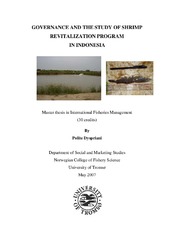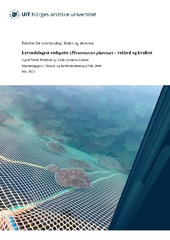Fishing efficiency of biodegradable PBSAT gillnets and conventional nylon gillnets used in Norwegian cod (Gadus morhua) and saithe (Pollachius virens) fisheries
Permanent link
https://hdl.handle.net/10037/14495Date
2018-09-10Type
Journal articleTidsskriftartikkel
Peer reviewed
Author
Grimaldo, Eduardo; Herrmann, Bent; Vollstad, Jørgen; Su, Biao; Føre, Heidi Moe; Larsen, Roger B.; Tatone, IvanAbstract
Fishing trials were carried out to compare the relative fishing efficiency of gillnets made of a new biodegradable resin (polybutylene succinate co-adipate-co-terephthalate, PBSAT) with conventional (nylon) nets. The fishing trials covered two consecutive fishing seasons (2016 and 2017) for cod (Gadus morhua) and saithe (Pollachius virens) in northern Norway. Results generally showed better catch rates for the nylon gillnets. The biodegradable PBSAT gillnets caught 50.0% and 26.6% fewer cod, and 41.0% and 22.5% fewer saithe than the nylon gillnets in 2016 and 2017, respectively. Even though the relative catch efficiency of the biodegradable gillnets was slightly better in 2017 than in 2016, the difference with respect to the catch efficiency of nylon gillnets may be too large for biodegradable gillnets to be accepted by fishermen if they were available commercially. Tensile strength measurements of the nylon and biodegradable PBSAT gillnets carried out before and after the fishing trials showed that the both types of gillnets had significant reductions in tensile strength and elongation at break, especially in 2017. Although less catch efficient than nylon gillnets, biodegradable PBSAT gillnets show great potential for reducing ghost fishing and plastic pollution at sea, which are major problems in these fisheries.
Description
This is a pre-copyedited, author-produced version of an article accepted for publication in ICES Journal of Marine Science following peer review. The version of record Grimaldo, E., Herrmann, B., Vollstad, J., Su, B., Føre, H.M., Larsen, R.B. & Tatone, I. (2018). Fishing efficiency of biodegradable PBSAT gillnets and conventional nylon gillnets used in Norwegian cod (Gadus morhua)and saithe (Pollachius virens) fisheries. ICES Journal of Marine Science, 75(6), 2245–2256, is available online at: https://doi.org/10.1093/icesjms/fsy108.
Publisher
Oxford University Press (OUP)Citation
Grimaldo, E., Herrmann, B., Vollstad, J., Su, B., Føre, H.M., Larsen, R.B. & Tatone, I. (2018). Fishing efficiency of biodegradable PBSAT gillnets and conventional nylon gillnets used in Norwegian cod (Gadus morhua) and saithe (Pollachius virens) fisheries. ICES Journal of Marine Science, 75(6), 2245–2256. https://doi.org/10.1093/icesjms/fsy108Metadata
Show full item recordCollections
Related items
Showing items related by title, author, creator and subject.
-
Governance and the study of shrimp revitalization program in Indonesia
Dyspriani, Polite (Master thesis; Mastergradsoppgave, 2007-05-29)Shrimp world production in the last few years has shown very high growth rates. It is marked by an increasing of production volume, and by shifting from capture to aquaculture fisheries within the production system. This has occurred mostly regarding to the brackish water pond. For some years, the government has had to face hard choices in order to ensure shrimp aquaculture developed sustainable. ... -
Levendelagret rødspette (Pleuronectes platessa) – velferd og kvalitet
Pettersen, Ingrid Marie; Aaknes, Vilde Synnøve (Master thesis; Mastergradsoppgave, 2023-05-15)I dag er verdikjeden for fisk og skalldyr bygget opp rundt utnyttelse av et fåtall arter som kan fanges i store volum og med høy markedsverdi. Bruk av lite eller ikke utnyttede marine ressurser kan være en bærekraftig tilnærming for å innfri fremtidige krav og etterspørsel til fiskekonsum. Rødspette (Pleuronectes platessa) er den viktigste flatfisken i volum og verdi i europeiske fiskerier. Både ... -
Boundary construction in mandated science : the case of ICES' advice on fisheries management
Nolde Nielsen, Kåre (Doctoral thesis; Doktorgradsavhandling, 2008-11-21)What is the relationship between science and politics? What should it be? How are their respective roles conceived and acted out in practice? Should science and politics be clearly separated? How? Are there cases in which they can be usefully mixed? What cases are those, and are there some ways of mixing that are better than others? This project explores such questions by examining relationships ...


 English
English norsk
norsk


